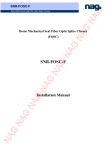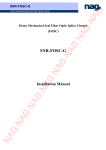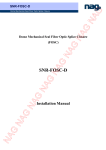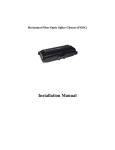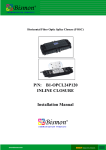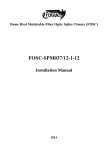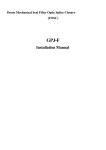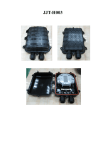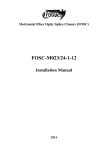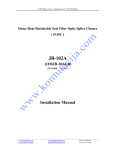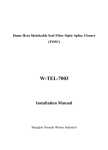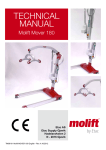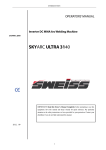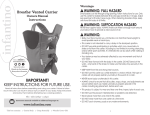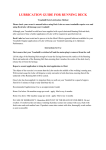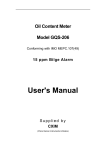Download SNR-FOSC-H installation manual
Transcript
SNR-FOSC-H Dome Mechanical Seal Fiber Optic Splice Closure Dome Mechanical Seal Fiber Optic Splice Closure (FOSC) SNR-FOSC-H Installation Manual SNR-FOSC-H Dome Mechanical Seal Fiber Optic Splice Closure 1. Scope of application This Installation Manual suits for the Fiber Optic Splice Closure (Hereafter abbreviated as FOSC), as the guidance of proper installation. The scope of application is: aerial, underground, wall-mounting,duct-mounting, handhole-mounting. The ambient temperature ranges from -40 to 65℃. 2. Basic structure and configuration 2.1 Dimension and capacity Outside dimension (Height x Diameter) 460mm×190mm Weight (excluding outside box) 2050g—2500g Number of inlet/outlet ports 4 pieces Diameter of fiber cable Φ8mm~Φ16 mm Capacity of FOSC Bunchy: 12-96 (cores), Ribbon: 144 (cores) 2.2 Main components No. Name of components Quantity Usage Remarks 1 Housing 1 piece on left and right side respectively (total 2 pieces) Protecting fiber cable splices in whole Height x Diameter 230mm x 150mm 2 Fiber optic splice tray (FOST) max. 4 trays (bunchy) max. 4 trays (ribbon) Fixing heat shrinkable protective sleeve and holding fibers Suitable for: Bunchy:12, 24 (cores) Ribbon: 3(pieces) 3 Foundation 1set Fixing internal and connecting external structure 4 Plastic hoop 1 set Fixing between left and right housing 5 Gasket ring 1 set Big gasket ring is used to seal between left housing and righting housing. Small gasket ring is used to seal inlet/outlet tube 1 piece of big gasket ring, 4 pieces of small gasket ring 6 Pressure testing valve 1 set After inject air, it is used for pressure testing and sealing testing Configuration as per requirement 1 SNR-FOSC-H Dome Mechanical Seal Fiber Optic Splice Closure 7 Earthing deriving device 1 set Deriving metallic parts of fiber cables in FOSC for earthing connection Configuration as per requirement 2.3 Main accessories and special tools No. Name accessories 1 Usage Remarks Heat shrinkable protective sleeve Protecting fiber splices Configuration as per capacity 2 Nylon tie Fixing fiber with protective coat Configuration as per capacity 3 Earthing wire 1 piece Putting through between earthing devices 4 Abrasive cloth 1 piece Scratching fiber cables 5 Labeling paper 1 piece Labeling fibers 6 Special wrench 2 pieces Installing and tightening nut of reinforced core and nut (plastic) of inlet/outlet tube 7 Measuring paper 1 piece To measure perimeter, of which its diameter is enlarged with seal tape 8 Seal tape 1 ring Enlarging diameter of fiber which fits in with gasket ring. cable 9 Insulation tape 1 ring Enlarging diameter of fiber for easy fixing cable 10 Hanging hook 1 set For aerial application 11 Buffer tube decided by customers Hitched to fibers and fixed with FOST, managing buffer. Desiccant 1 bag Put into FOSC before sealing for desiccating air. 12 of Quantity 3. Necessary tools for installation 3.1 Supplementary materials (to be provided by operator) Name of materials Usage Scotch tape Labeling, temporarily fixing Ethyl alcohol Cleaning Gauze Cleaning 2 Configuration as per specification Configuration as per requirement SNR-FOSC-H Dome Mechanical Seal Fiber Optic Splice Closure 3.2 Special tools (to be provided by operator) Name of tools Usage Fiber cutter Cutting off fiber cable Fiber stripper Strip off protective coat of fiber cable Combo tools Assembling FOSC 3.3 Universal tools(to be provided by operator) Name of tools Usage and specification Band tape Measuring fiber cable Pipe cutter Cutting fiber cable Electrical cutter Take off protective coat of fiber cable Combination pliers Cutting off reinforced core Screwdriver Crossing/Paralleling screwdriver Scissor Waterproof cover Waterproof, dustproof Metal wrench Tightening nut of reinforced core 3.4 Splicing and testing instruments (to be provided by operator) Name of instruments Usage and specification Fusion Splicing Machine Fiber splicing OT DR Splicing testing Provisional splicing tools Provisional testing Notice: The above-mentioned tools and testing instruments should be provided by the operators themselves. 3 SNR-FOSC-H Dome Mechanical Seal Fiber Optic Splice Closure 4. Installation flow chart 1. Open the closure 2. Determine length of fiber cable to be fixed and stripped inside FOSC 3. Strip off protective coats of fiber cable and fiber 4. Separate fiber cores and prepare work prior to fixing fiber cable 5. Fix fiber cable and reinforced core 6. Splice fibers 7. Install heat shrinkable protective sleeve and house fibers 8. Check up comprehensively 9. Assemble FOSC housing 10. Fix FOSC 4 SNR-FOSC-H Dome Mechanical Seal Fiber Optic Splice Closure 5. The process of installing FOSC. 5.1 Step One - Open the closure 5.1.1 Cleaning the locale and determine where to install the FOSC and then place fiber cables required. 5.1.2 Check whether the main components and accessories have been well prepared inside the package. 5.1.3 Open the closure ① Demount hoop fixing bolt and pull hoop locking system out, then proceed in demounting the hoop. ② Pull the left and right housings out to two ends, installation could begin. 5.1.4 See Drawing 1 Important issues: If the weather condition is not good enough, then a tent must be pitched for waterproof and dustproof. 5 SNR-FOSC-H Drawing 1 Hoop locking system Hoop fixing bolt Foundation Inlet/outlet tube Earthing device Octagonal nut (plastic) FOST cover Big gasket ring Hole for hanging hook FOSC housing Fixing device for reinforced core Pressboard Octagonal nut (plastic) Hole for hanging hook Hoop Dome Mechanical Seal Fiber Optic Splice Closure 5.2 Step Two -Determine length of fiber cable to be fixed and stripped inside FOSC ①. Fiber cable in 90mm length: the distance from small gasket ring to fiber cable pressboard ②. Fiber cable in 2000mm length: it is used to be winded and spliced after stripping. ③. Fiber with protective coat in 400mm length: the distance from the fixing point of fiber cable to the fixing point of FOST (fiber optic splice tray). ④. Fiber in 1600mm length: after stripping off the protective coat, it is to be winded inside the FOST after splicing with other fibers 5.2.2 See Drawing 2 Important issues: 1. Reserve enough length of fiber cable to be spliced. 2. Stripping length also could be decided by customer according to installation requirement. 5.2.1 6 SNR-FOSC-H Dome Mechanical Seal Fiber Optic Splice Closure ①90mm fixing length of fiber cable inside FOSC ②2000mm length of protective coat of fiber cable to be stripped off ③400mm length of fiber with protective coat ④1600mm length of protective coat of fiber to be stripped off Fiber cable Temp. locating mark 5.3 Drawing 2 Step Three – Strip off fiber protective coat of fiber cable and fiber 5.3.1 Strip off protective coat of fiber cable from the temp. locating mark with the cutter and the stripper, please refer to Drawing 2 for stripping length. Stripping length also could be decided according to installation requirement 5.3.2 See Drawing 3. Important issues: If it is difficult to strip off all the protective coat of fiber cable at one time, strip it off section by section to avoid fiber breakage. Stripping term inal fiber cable T em p locating m ark Inlet term inal fiber cable C utter D raw ing 3 5.4 Step Four – Separate fiber cores and prepare work prior to fixing fiber. 5.4.1 Wind 2 layers of insulation tape on protective coat of fiber. Meanwhile, get rid of the stuffing to separate fiber and clean them. Form a ring with the diameter of 100mm or so and fix it on the fiber temporarily by adhesive tape. 5.4.2 This FOSC is provided with 4 inlet/outlet ports. Number of fiber cables is determined by the customers according to their actual requirements and the corresponding number of port plugs should be taken out. The max number of fiber cables to be installed is 4. , The max diameters of fiber cables are all 16mm. 5.4.3 This FOSC is suitable for fiber cables with diameter ф16mm. 5.4.4 The corresponding inlet/outlet ports are to be selected according to fiber cables actually installed. When the diameter of fiber cable is smaller than that of the inlet/outlet port, then the sealing tape should be used to enlarge the diameter of fiber cable. 7 SNR-FOSC-H Dome Mechanical Seal Fiber Optic Splice Closure 5.4.5 Reserve reinforced core in 60mm length and cut off the unnecessary ones. 5.4.6 See Drawing 4. Important Issues: 1. Before the seal tape is used for enlarging the fiber cable diameter, it should be scratched and to be cleaned with abrasive cloth and ethyl alcohol. 2. Cut off reinforced core with a special cutting plier. Adhesive tape Seal tape Insulation tape Reinforced core Fiber with protective coat (Bunchy or ribbon) Fiber Drawing 4 5.5 Step Five - Fix reinforced core and fiber cable 5.5.1 Upon finishing the above steps, then demount port plugs, pressboard and fixing nut of reinforced core. Make sure to check whether the fiber cable stripped fits in with the fixing ports or not. If not, the adjustment should be done in time. Otherwise it will affect installation quality. 5.5.2 Insert fiber cable prepared into the FOSC. 5.5.3 Tighten fiber cable pressboard. If the diameter of fiber cable is not long enough, then enlarge it with insulation tape. 5.5.4 Tighten nut of reinforced core with the special wrench (plastic) and then retighten it with the metal wrench (the metal wrench should be provided by operator). 5.5.5 See Drawing 5 Fixing bolt Gasket Octagonal nut(plastic) Insulation tape Fiber Fixing nut for reinforced core Pressboard Fixing device for reinforced core Seal tape Fiber cable Reinforced core Small gasket ring Housing Fixing seat Foundation Fiber with protective coat Drawi ng 5 5.6 Step Six - Splice fibers 5.6.1 Follow user manual of fusion splicing machine to splice fibers. Important issue: pay attention to the twist and bend of fiber. 8 Adhesive tape SNR-FOSC-H Dome Mechanical Seal Fiber Optic Splice Closure 5.7 Step Seven -Install heat shrinkable protective sleeve and house fibers 5.7.1 When having completed splicing the fibers, the first fiber ring should be housed on the farthest side of FOST, the remaining fiber should be winded, forming a ring with diameter not less than 80mm. then put it into FOST (Fiber Optic Splice Tray) together with heat shrinkable protective sleeve. ( Firstly fix heat shrinkable protective sleeve into the slot, then enlarge the diameter of fiber ring properly.) 5.7.2 See Drawing 6 Important issue: pay attention to the twist and bend of fiber. N ylon tie L eft term in al fib er w ith p rotective coat H eat sh rinkable p ro tective sleeve F ib er G rom m et Fixin g slot of heat s hrinkable p rotective sleeve (bunchy) FOST R ight term inal fiber w ith p rotective coat D raw ing 6 5.8 Step Eight - Check up comprehensively To ensure the technical requirements, the following instructions must be followed: 5.8.1 The fibers in the FOST are spliced and installed orderly. The curved diameter of fiber meets with the technical requirements. 5.8.2 The internal tighteners are tightened. 5.8.3 The inlet/outlet ports without fiber cables must be blocked up with the original port plugs. 5.8.4 Control the amount of seal tape within a proper range. 5.8.5 Seal fitting is installed neatly and smoothly. If not, level it up with seal tape. 5.8.6 See Drawing 7 9 Small gasket ring Grommet Terminal A fiber with protective coat FOSC housing Reinforced core Gasket Pressboard Octagonal nut (plastic) FOST cover Terminal B fiber with protective coat Big gasket ring 10 Fixing device for reinforced core Fixing seat Fixing device for reinforced core Pressboard FOSC housing Nylon tie Hole for hanging hook Foundation Small gasket ring Grommet Earthing device Gasket Fixing seat Octagonal nut (plastic) Drawing 7 Octagonal nut (plastic) Terminal A Fiber cable FOST Fiber Inlet/outlet tube SNR-FOSC-H Octagonal nut (plastic) Dome Mechanical Seal Fiber Optic Splice Closure Terminal B Fiber cable SNR-FOSC-H Dome Mechanical Seal Fiber Optic Splice Closure Step Nine – Assemble FOSC housing Insert one end of foundation into one end of orbit of FOSC, then hitch another end of orbit of FOSC to another end of foundation properly. 5.9.2 Install plastic hoop between left and right housing, tighten hoop locking system, which is to be fixed by hoop fixing bolt then. 5.9.3 Please refer to Drawing 8. H oop lock in g system H oop Drawing 8 O ctagon al n ut (p lastic) H oop fixing bolt O ctagon al n ut (p lastic) FOSC housing FOS C orbit H ole for hanging hook Pressboard FOS T cover FOSC housing H ole for hanging hook In let/ou tlet tube 5.9.1 Fixin g d evice for rein forced core 5.9 11 Octagonal nut (plastic) Fiber cable Hole for hanging hook Hoop fixing bolt FOSC housing Hoop Drawing 9 FOSC housing 12 Hole for hanging hook Octagonal nut (plastic) Fiber cable Hole for hanging hook 5.10 Hole for hanging hook SNR-FOSC-H Dome Mechanical Seal Fiber Optic Splice Closure 5.10.1 Fix FOSC by tightening octagonal nut. 5.10.2 If for aerial application, hanging hook is to be installed. Step Ten – Fix FOSC SNR-FOSC-H Dome Mechanical Seal Fiber Optic Splice Closure 6. Fiber Optic Splice Closures (FOSC) inspecting and testing items Inspecting type Inspecting item Technical Requirements Package Each small package contains one fiber optic splice closure, together with its accessories, tools, installation manual and packing list. Appearance Intact in shape, no burrs, bubbles, chaps, pores, warps, impurities and other defects, all background colors should be even and continual. Sign There is a clear sign on the housing, such as name and model of the product, etc. Fiber storage device The fibers reserved are to be winded in fiber optic splice tray (FOST), the length of fibers housed in FOST is >1.6m, the curved radius is >30mm. During the installation and maintenance, there should be no attenuation on fibers. Electrical jointing device Inside FOSC: metallic components of fiber cables has the functions of electrical putting through, earthing connection and disconnecting. It is possible to install earthing deriving device outside the housing Sealing performance After sealing according to the stipulated operation procedures, the injected air pressure is 100KPa±5Kpa, when immersed in clean water of normal temperature for 15 minutes, there should be no air bubbles, then observed for 24 hours, there should be no change of air pressure. Re-sealing performance After reopening and resealing according to the stipulated operation procedures, the injected air pressure is 100KPa ± 5Kpa, when immersed in clean water of normal temperature for 15 minutes, there should be no air bubbles, then observed for 24 hours, there should be no change of air pressure. Pull Bearing pull is ≧ 800N at axle orientation, there should be no breakage on the housing. Punching Bearing pressure of 2000N/10cm for 1 minutes, there should be no breakage on the housing 13 Routine test (Before leaving factory) Type test full At least 3 sets sampled each time At least 3 sets sampled each time SNR-FOSC-H Dome Mechanical Seal Fiber Optic Splice Closure Impact Bearing impact energy of 16N•m, 3 times of impacts there should be not breakage on the housing Bending The spot between the FOSC and seal fitting can bear bending tension of 150N at bending angle of ±450 for 10 circles, there should be no breakage on the housing Torsion Bearing torsion 50N•m, 10 circle at torsion angle±900, There should be no breakage on the housing. Temperature circle Injected air pressure of 60KPa±5 KPa, the temperature circle ranging from -40℃~+65℃, 10 times of the circular tests (one circular consists of high temperature for 2 hours + indoor temperature for 2 hours + low temperature for 2 hours + indoor temperature for 2 hours ) when the pressure declines, the amplitude is ≦5Kpa, immerse the swatch in clean water of normal temperature for 15 minutes, there should be no air bubbles. Voltage resistance strength After sealing the FOSC according to the stipulated operation procedures, immerse it in clean water of normal temperature in 1.5m depth for 24 hours, there should be no breakdown or arc over between the metallic components of the FOSC, between metallic components and the ground at DC 15KV for 1 minutes. Isolating resistance After sealing the FOSC according to stipulated operation procedure, immerse it in clean water in 1.5m depth for 24h, the isolating resistance between the metallic components of the FOSC, between the metallic components and the ground should be ≧ 2×104MΩ. 14 full At least 3 sets sampled each time At least 3 sets sampled each time SNR-FOSC-H Dome Mechanical Seal Fiber Optic Splice Closure GUARANTEE: CONTACT: Address: Building 118, Vonsovskogo Street 1, Yekaterinburg, Russia Tel: +7(343) 379-98-38 Fax: +7(343) 379-98-38 E-mail: [email protected] Online shop: http://shop.nag.ru 15
















